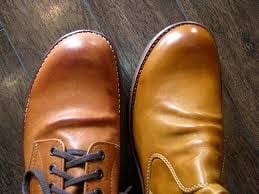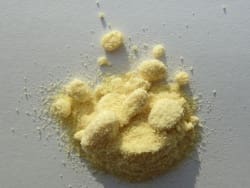Tanning is the process of treating skins and hides of animalsto produce leather. A tanning agent displaces water from the interstices between the protein fibers and cements these fibers together. A tannery is the place where the skins are processed. Traditionally, tanning used tannin, an acidic chemical compound from which the tanning process draws its name.
Tanning hide into leather involves a process which permanently alters the protein structure of skin, making it more durable and less susceptible to decomposition, and also possibly coloring it.

Before tanning, the skins are dehaired, degreased, desalted and soaked in water over a period of six hours to two days. Historically this process was considered a noxious or “odoriferous trade” and relegated to the outskirts of town.
At the end of beam house operations, the main component of hides is structured collagen, that is ready to be transformed into leather. Once a skin is tanned some typical properties are expected to appear. The first feature is an outstanding resistance to putrefaction (it is common knowledge that some leather artifacts dated back to thousands years ago are still preserved); in a more general perspective a tanned skin is awaited to be softer than it was in the raw state, often with a typical color and smell; all the changes given by tanning should be permanent. Technically speaking, an increase in shrinking/ denaturation temperature also accompanies the transformation of skin in leather, measured as resistance to wet heat (hydrothermal resistance). The transition to leather requires permanent incorporation of chemical species into the collagen network; however, until the twentieth century, few tanning chemistries were known and applied by fellmongers. The three most widely used tanning agents are vegetable tannin, mineral salts such as chromium sulfate, and fish or animal oil.
- VEGETABLE TANNING
Vegetable tanning uses tannins (a class of polyphenol astringent chemicals), which occur naturally from plants. Among all, the most commonly used are leaves, bark, galls, sawdust, olive leaves, rhubarb roots or mimosa. These substances are placed in a pit along with the skins and hides. As these tannins are derived from plants, the leather is called vegetable-tanned leather. Also the term “natural leather” is used.

Tanning with plant substances has existed for over 5,000 years and was, for many centuries, the main tanning method. Vegetable tanning is based on tannins (polyphenols and gallic acid) which are found naturally in plant species. Tannins bind to the collagen proteins in the hide and coat them, causing them to become less water-soluble and more resistant to bacterial attack. The process also causes the hide to become more flexible.Tannins are found in varying concentrations in different plants. In addition to the plants mentioned above, tannins are also contained in wine, chestnuts, hops, sumac and black and green tea. In food, tannins are perceived as dry, rough and furry. The taste of red wine is fundamentally influenced by the type of tannins and their concentration. Many plants used for leather tanning require up to 30 years growth, to allow sufficient amounts of tannins to be produced. Other plants contain more tannins when they are younger. There are around 300 different plant species worldwide, which can be used for tanning.
Hides that have been stretched on frames are immersed for several weeks in vats of increasing concentrations of tannin. Vegetable-tanned hide is not very flexible. It is used for luggage, furniture, footwear, belts, and other clothing accessories. Recently, the more modern and industrialized tanning methods have become common and it can be assumed that nowadays only 10 – 12% of all leather is vegetable-tanned.

Vegetable tannins – Quebracho wood
- Oakis suitable for all leather. Oak and spruce bark from younger trees are used, because they contain more tannin.
- Chestnutgives a hard and reddish leather.
- Mimosa barkand Acacia make leather rather pliable and supple.
- Valoneais a Mediterranean, wild species of oak, which grows mainly in Turkey and in Greece. Dried Valonea acorn cups (also called Trillo) have a high tannin content, between 32% and 45%. Valonea is used to make soft and tough leather. Valonea-tanned leather has higher color- fastness ratings in comparison to other vegetable-tanned leather.
- Bark from the flat topped yateor swamp yate (eucalyptus occidentalis) has an extremely high tannin content of 46 – 49%. The tree grows in West Australia and is up to 25 meters high. Since the plant is now rare, the tannin is hardly used.
- CHROME TANNING

Chromium sulfate has long been regarded as the most efficient and effective tanning agent. Tanning with chromium salts, introduced at the end of the 19th century, was probably the first change in the chemistry of leather production in at least 2,000 years. Two methods are used. In the double-bath method the hides are first bathed in a mild chromic acid solution. In the second bath, sodium sulfate and another acid react with the chromic acid to produce basic chromium salts, which are deposited on the fibers of the skins. In the more common single-bath method the hides are soaked in revolving drums filled with increasingly strong chromium sulfate solutions. Aluminum and zirconium salts are also used in tanning.
- FATS AND OIL TANNING
 Fats and Oil tanning is an ancient method that is used for such soft, porous leathers as chamois and deerskin, which can be repeatedly wetted and dried without detrimental effects. It involves using fat-rich animal substances such as brain, fish oil, sebum or marrow. It can also be done with soap, claw oil, yak butter or egg yolk. In olden times, animals were mainly hunted for food, clothing and shelter and using animal fats to preserve their skins was common practice. Fish oil is sprinkled onto the hides and pounded in with mechanical hammers. The hides are then hung in ovens, and the oxidized oil adheres to the skin fibers.
Fats and Oil tanning is an ancient method that is used for such soft, porous leathers as chamois and deerskin, which can be repeatedly wetted and dried without detrimental effects. It involves using fat-rich animal substances such as brain, fish oil, sebum or marrow. It can also be done with soap, claw oil, yak butter or egg yolk. In olden times, animals were mainly hunted for food, clothing and shelter and using animal fats to preserve their skins was common practice. Fish oil is sprinkled onto the hides and pounded in with mechanical hammers. The hides are then hung in ovens, and the oxidized oil adheres to the skin fibers.
Fish oil tannage also represents an historical technique that is nowadays almost abandoned. The resulting leather is typically yellowish and shows an extraordinary capacity to absorb water. Before synthetic materials, it was used for car-wash cleaning, fuel filtration and for sweat absorption in long term patients.
- SYNTHETIC TANNING
Synthetic tanning is frequently used as an alternative to chrome tanning.

Synthetic tanning agent
Synthetic tanning agents (aromatic syntans) are produced artificially, so have no counterpart in nature. Examples of these include formaldehyde, glutaraldehyde, phenols and acrylates. The synthetic tanning method is not employed as an isolated tanning process, but mostly as part of a combination tanning process with either chrome tanning or vegetable tanning. Chrome leather production ensures retanning with synthetic tanning agents as they provide the necessary “fullness” to the leather. It is estimated that annual production of synthetic tanning agents amount to 200,000 tonnes (2008).
After tanning, when the leather is still wet and not dyed, it gets a bright color and hence is also referred to as wet white.

Shrinkage of synthetic tanned car leather due to moisture in leather and sun.
A disadvantage of chrome-free synthetic tanned leather is its sensitivity to moisture in the leather, plus heat. Approx. 50% of all car leather is FOC. If a convertible is rained on, a liquid runs out and if a wet towel or a wet swim suit remains too long on the leather, moisture migrates through the finish, the seam holes or the perforation holes. If sun shines on such wet leather, the matrix water (chemically bound in leather) starts boiling and the leather hardens and shrinks.
- BRAIN TANNING
The tanning of animal skins with animal brain mass is an almost forgotten method and is rarely practised today. Historically, brain tanning was mainly done by North American Indians who also used smoke as a way of preserving the skins. This leather was also called “Indian leather” and “buckskin”.


This tanning process was also familiar to the Zulus in Africa, the Sami in Scandinavia and the different groups of people from Asia. The hides of all mammals are suitable for brain tanning. The larger the skin, the harder the work.
Advantages of brain tanning: The brain was always readily available after the animals were killed and tanning with brain is a very fast process. It only takes a few days. Also, the technical effort is low and it is easy to make the leather soft. This method involves 100% natural products, so there is no need for additional “chemistry”.
But there are disadvantages. Brain tanning is high on manual labor and the process is not as easy, compared to alternative tanning methods. The skin layer of the hair side, as well as the fat and flesh remnants of the back, must be carefully and thoroughly removed so that the brain can fully penetrate the fibers. This is the only way to ensure the leather gets beautifully soft. The brain mass must be pressed into the fiber with considerable effort.
To ensure a long-lasting softness of the leather, it was traditionally stored in a special tent over wood smoke, which gave the skin a dark brown tone and also made it waterproof, thus achieving better protection. Without this process, the leather turns out to be whitish and water-sensitive.
- TAWING WITH ALUM – ALUM TANNED
Tawing is a method of tanning with aluminium salts (alum). It is a naturally-occurring double salt, but which is also artificially produced. Tawing comes under mineral tanning and is one of the oldest tanning process. After tanning with alum, the dried leather is stiff and firm. To make it softer, the leather is then tumbled and greased.
Alum tanning makes the leather white and very water-sensitive. The tannins are washable, making this leather much more sensitive than with chrome tanning which, with a few exceptions such as for Sheep skin, has replaced alum tanning.
- Potash alum was also renowned as tanning agent and was often used in combination with vegetable tanning (semi-alum leather).
- Wood fumigation was also known to stabilize animal skins and was
practiced by some communities.
Reference:
Tanning (leather). (2020, July 14). Retrieved July 21, 2020, from https://en.wikipedia.org/wiki/Tanning_(leather)
The Editors of Encyclopaedia Britannica. (2018, February 19). Tanning. Retrieved July 21, 2020, from https://www.britannica.com/technology/tanning
Leather Tanning Process: Technical and processing |. (n.d.). Retrieved July 21, 2020, from https://www.mastrotto.com/tanning-process/
Vegetable-tanned leather. (n.d.). Retrieved July 21, 2020, from https://www.leather-dictionary.com/index.php/Vegetable-tanned_leather
Brain tanning. (n.d.). Retrieved July 21, 2020, from https://www.leather-dictionary.com/index.php/Brain_tanning
Synthetic tanned. (n.d.). Retrieved July 21, 2020, from https://www.leather-dictionary.com/index.php/Synthetic_tanned
Tanning with fats and oils. (n.d.). Retrieved July 21, 2020, from https://www.leather-dictionary.com/index.php/Tanning_with_fats_and_oils
Tawing with alum. (n.d.). Retrieved July 21, 2020, from https://www.leather-dictionary.com/index.php/Tawing_with_alum

